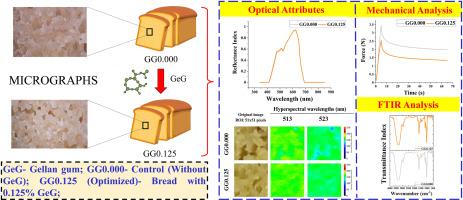Gellan gum as a clean-label additive to improve whole wheat bread characteristics: A multimodal characterization approach
IF 11
1区 农林科学
Q1 CHEMISTRY, APPLIED
引用次数: 0
Abstract
This study delineated the concentration-dependent effects of gellan gum (GeG; 0–2.000 % w/w) on the physicochemical attributes of whole wheat bread (WWB) formulations. Nine formulations were systematically examined using a multimodal analytical framework comprising surface microscopy, colorimetric analysis, hyperspectral imaging, texture profile analysis, stress relaxation studies, and FTIR spectroscopy. Among the tested concentrations, the 0.125 % GeG (GG0.125) formulation demonstrated the most balanced alignment with the control (GG0.000, without GeG). Texture profile analysis revealed that GG0.125 exhibited comparable hardness, springiness, cohesiveness, and resilience to the control. Stress relaxation analysis further confirmed that GG0.125 preserved viscoelastic behaviour, as evident from the comparable F60 (1.344 N) and %SR (47.217 %) values to those of the control. Microscopic examination revealed a smoother crumb surface and more homogeneously distributed pores in the GG0.125 sample, indicating an enhanced internal structure. FTIR spectra showed strong correlation with the control (ρ = 0.99639) and minimal shifts in amide and carbohydrate bands, reflecting preserved molecular organization. Hyperspectral imaging at 477, 513, 523, and 619 nm further revealed uniform chromophore distribution in GG0.125, comparable to that of the control. Collectively, these findings establish 0.125 % GeG as the optimal concentration capable of maintaining the structural, mechanical, and molecular features of the control formulation, thereby supporting its application in clean-label bread reformulation.

结冷胶作为一种清洁标签添加剂改善全麦面包的特性:一种多模态表征方法
本研究描述了结冷胶(GeG; 0-2.000 % w/w)对全麦面包(WWB)配方的理化性质的浓度依赖性影响。使用多模态分析框架,包括表面显微镜、比色分析、高光谱成像、纹理剖面分析、应力松弛研究和FTIR光谱,系统地检查了九种配方。在测试浓度中,0.125% GeG (GG0.125)配方与对照(GG0.000,不含GeG)的一致性最平衡。织构分析表明,GG0.125的硬度、弹性、黏结性和回弹性与对照相当。应力松弛分析进一步证实,GG0.125保留了粘弹性行为,这一点从F60 (1.344 N)和%SR(47.217%)值与对照组的比较中可以看出。显微检查显示,GG0.125样品的碎屑表面更光滑,孔隙分布更均匀,表明内部结构增强。FTIR光谱与对照有较强的相关性(ρ = 0.99639),酰胺和碳水化合物带的变化最小,反映了分子组织的保存。在477,513,523和619 nm处的高光谱成像进一步显示GG0.125中的发色团分布均匀,与对照相当。总的来说,这些发现确定0.125% GeG是能够保持对照配方结构、机械和分子特征的最佳浓度,从而支持其在清洁标签面包再配方中的应用。
本文章由计算机程序翻译,如有差异,请以英文原文为准。
求助全文
约1分钟内获得全文
求助全文
来源期刊

Food Hydrocolloids
工程技术-食品科技
CiteScore
19.90
自引率
14.00%
发文量
871
审稿时长
37 days
期刊介绍:
Food Hydrocolloids publishes original and innovative research focused on the characterization, functional properties, and applications of hydrocolloid materials used in food products. These hydrocolloids, defined as polysaccharides and proteins of commercial importance, are added to control aspects such as texture, stability, rheology, and sensory properties. The research's primary emphasis should be on the hydrocolloids themselves, with thorough descriptions of their source, nature, and physicochemical characteristics. Manuscripts are expected to clearly outline specific aims and objectives, include a fundamental discussion of research findings at the molecular level, and address the significance of the results. Studies on hydrocolloids in complex formulations should concentrate on their overall properties and mechanisms of action, while simple formulation development studies may not be considered for publication.
The main areas of interest are:
-Chemical and physicochemical characterisation
Thermal properties including glass transitions and conformational changes-
Rheological properties including viscosity, viscoelastic properties and gelation behaviour-
The influence on organoleptic properties-
Interfacial properties including stabilisation of dispersions, emulsions and foams-
Film forming properties with application to edible films and active packaging-
Encapsulation and controlled release of active compounds-
The influence on health including their role as dietary fibre-
Manipulation of hydrocolloid structure and functionality through chemical, biochemical and physical processes-
New hydrocolloids and hydrocolloid sources of commercial potential.
The Journal also publishes Review articles that provide an overview of the latest developments in topics of specific interest to researchers in this field of activity.
 求助内容:
求助内容: 应助结果提醒方式:
应助结果提醒方式:


